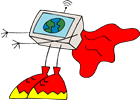 Charts and Graphs
Charts and Graphs
Visualize data with charts and graphs.
Use charts and graphs in your learning spaces.
- Screen shots from Interactives such as Grapher
- Built-in graphing tools in PowerPoint
- Build your own by providing tools using lines and shapes
- Make the graphic outline.
- Provide squares to move around the screen to make the chart based on the story problem
 Visualizing Math Concepts
Visualizing Math Concepts
Introduce measurement using standard and nonstandard units using Measuring Penny by Loreen Leedy and a PowerPoint starter. Use nonstandard measure such as raisins, coins, toy cars, erasers, etc. Visualize with graphics and charts.
Variations
Start with a math book. For young children, read aloud the book in PowerPoint and ask students to read along in the book. Consider the following books as starters:
- 2 x 2 = Boo!: A Set of Spooky Multiplication Stories by Loreen Leedy
- Alexander, Who Used To Be Rich Last Sunday by Judith Viorst
- Each Orange Had 8 Slices: A Counting Book by Paul Giganti, Jr.
- Follow the Money by Loreen Leedy
- The Great Graph Contest by Loreen Leedy
- How Much Is a Million by David Schwartz
- Math Curse by Jon Scieszka and Lane Smith
- Much Bigger than Martin by Steven Kellogg
- The Mud Flat Olympics by James Stevenson
- My Place in Space by Robin and Sally Hirst
- One Hundred Hungry Ants by Elinor Pinczes
- The Purse by Kathy Caple
- Subtraction Action by Loreen Leedy
- The Very Hungry Caterpillar by Eric Carle
- Need More Ideas? Go to Math and Children's Literature
Lesson Ideas
Adapt one of the following lessons that involves using a chart. What is the benefit of a computer-based chart? How could this be used in a learning center or collaborative project?
Pre-K-2 Lesson Ideas
Grades 3-5 Lesson Ideas
Incorporate charts and graphs into a desktop learning space assignment. You may wish to adapt the Measuring Penny example or start from scratch.

